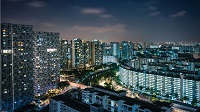Yet, Singapore is blazing a trail towards a sustainable energy future. Through our Four Switches — Solar Energy, Regional Power Grids, Low-Carbon Alternatives, and Natural Gas — we are reshaping the way we produce energy. We are also ramping up efforts in energy efficiency to manage demand, propelling us towards a clean energy future.
Singapore aims to achieve net zero emissions by 2050. The power sector plays a critical role, as it currently contributes to about 40% of Singapore’s carbon footprint. This is challenging given Singapore's limited options for scaling up renewable energy sources.
Shining Bright with Solar
With year-round sunshine, solar energy is Singapore’s most promising renewable energy source. We are one of the most solar dense cities in the world and have attained 1.17 gigawatt-peak (GWp) of solar deployment as of Q4 2023, more than halfway towards achieving our target of 2 GWp by 2030.
Growth of Solar Capacity and Installations
- Installed Capacity
- Number of PV Systems
Regional Interconnectivity
The Lao PDR-Thailand-Malaysia-Singapore Power Integration Project (LTMS-PIP) is a pathfinder project aimed at enhancing regional power connectivity and energy security in ASEAN.
Joint Statement of the LTMS-PIP
In August 2023, the fourth Joint Statement of the LTMS-PIP re-affirmed the commitment of the four parties to advancing multilateral cross-border power trade in ASEAN. We agreed to continue to trade up to 100 megawatts of power under the current LTMS-PIP, and to explore opportunities to increase trading capacity and enable multidirectional power trade.
Conditional Approvals for Electricity Imports
Low-carbon electricity imports through regional power grids are a key enabler in decarbonising Singapore's energy supply. These imports can help to accelerate renewable energy development in the region, facilitate economic growth, and diversify energy sources away from fossil fuels.
Projects that are preliminarily assessed to be technical and commercially viable are granted Conditional Approvals. To date, EMA has granted 4.2 gigawatts (GW) of Conditional Approvals to imports from various sources, comprising 2 GW from Indonesia, 1 GW from Cambodia and 1.2 GW from Vietnam.
If realised, these projects will collectively tap on a diverse mix of solar energy, hydropower, and wind power.
Going the Distance with Low-Carbon Solutions
EMA is also exploring innovative low-carbon alternatives to ensure a secure, reliable, and sustainable power system.
Using Ammonia for Power Generation and Bunkering Project
One such example is hydrogen, which can be transported using carriers such as ammonia. EMA and the Maritime and Port Authority of Singapore have shortlisted six consortiums from an Expression-of-Interest who were invited to a Restricted Request for Proposal to provide a low- or zero-carbon ammonia solution for power generation and bunkering on Jurong Island.
Based on the proposals received, the Government will identify a lead developer for the project, potentially making it one of the first commercial projects to test and deploy ammonia as a fuel in a gas turbine.
Assessing Geothermal Potential Across Singapore
Advances in drilling technology can potentially unlock geothermal energy as a renewable energy source for Singapore. In April 2024, EMA awarded a contract to a consortium, led by Surbana Jurong Infrastructure Pte. Ltd., to conduct a geophysical study assessing Singapore’s deep geothermal resource potential.
Scheduled to be completed by 2026, positive results could lead to applications in power generation, cooling, and direct heating.
Keeping the Lights On
Having secure and reliable supplies of natural gas are essential as we scale up the other Switches.
New Emission Standards for Power Generation Units
Over the next decade, new and upgraded power generation units are needed to keep up with rising electricity demand and replace ageing plants.
In October 2023, EMA announced it will be putting in place emission standards for new and repowered fossil fuel-fired power generation units. This encourages the use of best-in-class technology to reduce carbon emissions from electricity generation.
Optimising Energy Demand Management
As energy demand rises with increasing electrification and growth of energy-intensive sectors, it becomes crucial to manage demand effectively.
Residential Demand Response Pilot
In July 2024, EMA and SP Group (SP) started a first-of-its-kind Residential Demand Response pilot. Households equipped with smart meters can receive alerts via the SP app to reduce or shift electricity consumption during peak demand periods, earning monetary incentives. Households can take action by deferring the use of home appliances such as washing machines or dishwashers, or reducing air-conditioning usage.
Incentivising Commercial and Industrial Consumers
To encourage voluntary reduction in electricity demand, EMA implements the Demand Response (DR) and Interruptible Load (IL) programmes. These programmes incentivise eligible business consumers to reduce peak demand when wholesale electricity prices are high, and be on standby to reduce electricity demand when necessary to improve system reliability, respectively.
Since the announcement of a two-year regulatory sandbox for the DR and IL programmes in October 2022, our demand-responsive load has increased 1.5 times, and is over 100 megawatts now. EMA will continue to engage the industry to attract new participants, supporting Singapore’s transition to a more resilient energy system.

















